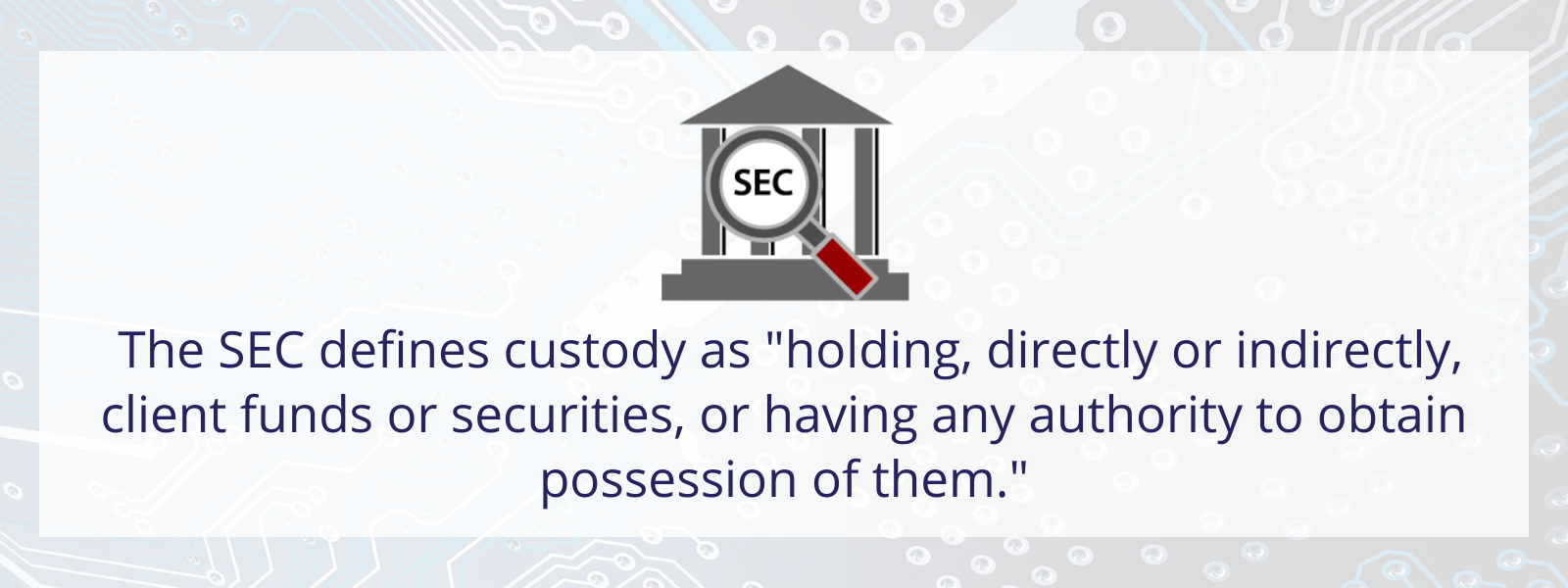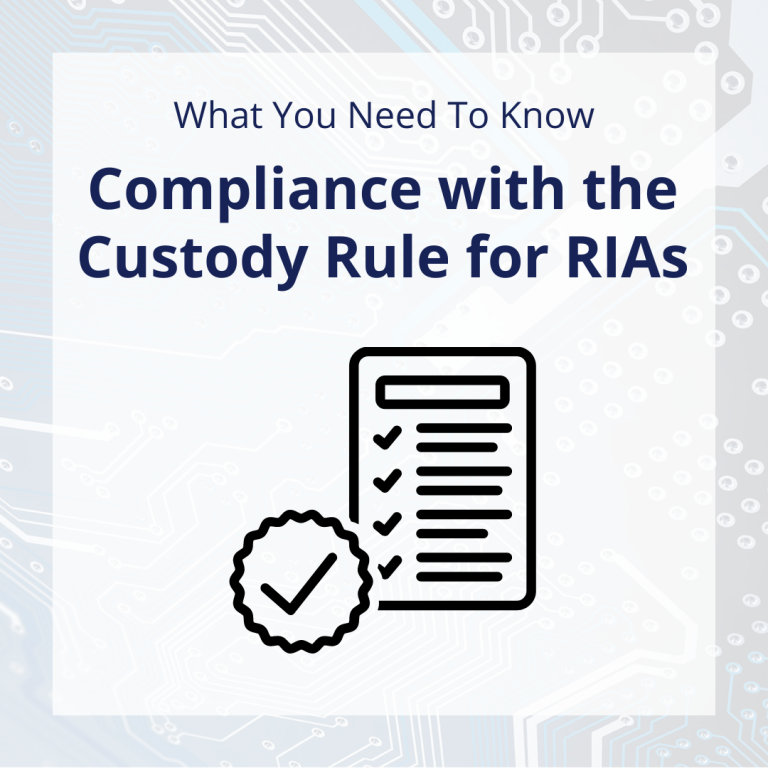As compliance consultants to registered investment adviser (“RIA”) firms, we understand that there is often uncertainty about the interpretation of the custody rule. The Securities and Exchange Commission’s (“SEC”) Rule 206(4)-2 of the Adviser’s Act, also known as the custody rule, governs the holding of client securities and funds by federally registered RIA firms. In this blog post, we provide an overview of state and federal custody rules, common deficiencies, and the requirements for RIAs.

The SEC definition includes any “related person” of a firm, which means an individual, a corporation, a partnership, an association, a joint-stock company, a trust, any unincorporated organization, or a government or political subdivision thereof, that is controlling, controlled by or under common control with the RIA. The individual could be any advisory affiliate, employees, or independent contractors hired as IARs. Therefore, advisers must be careful, because they can be deemed to have custody through a related person, which could be another entity).
It’s important to note that each state has its own individual investment adviser custody requirements. Like many regulatory rules, some states’ may closely follow the requirements of the SEC, but there are also states with their own unique regulatory requirements. Therefore, we highly recommend that all RIA firms review the custody requirements in their relevant jurisdictions to determine if the firm may be deemed to have custody.
The North American Securities Administrators Association (“NASAA”) model rule “USA 2002 411(f)-(1) Custody Requirements for Investment Advisers,” defines custody as follows: “Custody means holding, directly or indirectly, client funds or securities, or having any authority to obtain possession of them `or has the ability to appropriate them`. The investment adviser has custody if a related person holds, directly or indirectly, client funds or securities, or has any authority to obtain possession of them, in connection with advisory services the investment adviser provides to clients.”
While this is almost identical to the SEC rule, one main difference between the SEC and state ruling involves obtaining checks made payable to third parties (the custodian). The NASAA model rule indicates that the possession of the checks puts the firm or related person in custody (even though they cannot cash the checks) IF the checks are not forwarded to the custodian promptly, typically within three business days (this could be 24 hours in some jurisdictions).
The receipt of checks drawn by clients must also be properly recorded under Rule 411(c) in order to exempt the firm from custody. The records need to log the date received, the client’s name, the date delivered, the check number, and how the check was delivered. While not specifically required by the SEC custody rule, it would still be a recommended practice for SEC registered firms. It’s also important to note that checks inadvertently made payable to the RIA firm for investment purposes should be returned to the client as soon as possible, but always within three business days.
Below are a list of requirements for advisory firms with custody of client funds or securities. For more information, please visit the SEC Guide here.
- Disclosure on Form ADV Documents/Notice to Administrator (NASAA model rule)
- Assets maintained at a qualified custodian
- Notice to clients
- Account statements to clients
- Statements from the custodian at least quarterly
- Pooled investments statements for each investor
- Independent verification (Surprise Examination)
- Engage services of independent CPA
- CPA will have reporting requirements on Form ADV
- First exam must occur within 6 months, then annually thereafter
- Engage services of independent CPA
- Form ADV-E
Exceptions (these are not all encompassing):
- Certain privately offered securities to do not require a qualified custodian
- Independent verifications/ surprise exams are not required for SEC registered firms IF the only form of custody is direct fee deduction AND the qualified custodian is not a related person.
- Independent verifications/surplus exams are not required for state registered firms IF the only form of custody is direct fee deduction. About half of the states also require an itemized invoice, including the calculation, each time a fee is deducted, written authorization, and a notification to the administrator in writing of the intent to use the safeguards (ADV Part 1B).
Common Deficiencies:
Often, RIA firms assume they do not have custody if they are utilizing a traditional RIA custodian to manage all client accounts separately. However, there are several scenarios that the SEC has identified, in which the RIA firm may fail to identify that it is deemed to have custody. Some scenarios include obtaining passwords for their client’s accounts, acting as a trustee, and having power of attorney over any client’s account. Keep in mind, simply having access to withdraw, trade, or manage the client funds or securities constitutes custody.
Standard Letters of Authorization (“SLOA”) No Action Relief
In 2017, the SEC released further guidance on the custody rule provision related to standing letters of authorization (SLOA). The no-action letter indicates that an RIA firm with a SLOA with a client has custody of the assets. However, the SEC would not recommend enforcement action for an advisor avoiding the independent verification (surprise exam) IF seven specific steps were taken. Learn more about the seven steps within the standing letter of authorization custody guidance in our blog post here.

